|
Shoko Nakagawa, known to her fans as "Shoko-tan" (-tan being a "baby-talk" variation on -chan), is further known throughout anime fandom as the weird idol chick who puts cats in her mouth. Somehow she has managed to grab a couple notable roles under her belt while playing-up her "shtick" at the same time — the special notch-eared Pichu in Pokémon, performer of the Tengen Toppa Gurren Lagann opening theme, and more.
Nakagawa was introduced to the more-secluded, DragonBall-specific side of fandom back in 2007 with a short EP of anime cover songs. The lead single off the release was a cover of "Romantikku Ageru yo", the opening theme to the first DragonBall TV series. It was accompanied by a music video that played extreme homage to the original animation for the theme song. We were (surprisingly!) somehow impressed with the end result, especially coming from an area of anime culture that had never truly approached our franchise (and when it would again, it would horribly fail).
Three years later and with her third "cover songs" release, Nakagawa is back at it again with our favorite franchise. It is a slightly confusing release — the regular version of the disc contains a cover of "Detekoi Tobikiri ZENKAI Pawâ!" (the first ending theme to the DragonBall Z TV series), while the "special" version contains that song as well as a slew of bonus tracks, including a TV-sized version of "DAN DAN Kokoro Hikarete 'ku" (the opening theme to the DragonBall GT TV series, as well as the ending theme to DragonBall's 10th anniversary movie).
We felt that Nakagawa nailed the burikko, not-quite-but-kinda-"cutesy" and halfway-respectful performance of "Romantikku Ageru yo", but how would her standard tone and demeanor translate to these other two songs?
Title: |
"Shoko-tan Cover 3 ~Anison ni Ai wo Komete!!~" |
Artist: |
Shoko Nakagawa |
Catalogue #: |
SRCL-7220 (Regular)
SRCL-7218 (Special) |
Publisher: |
Sony Music Entertainment |
Release Date: |
10 March 2010 |
Price: |
¥2800 (Regular)
¥3500 (Special) |
Tracks: |
12 (Regular)
18 (Special) |
|
The review of this CD was made possible by your referral purchases on CDJapan. If you are interested in contributing to the site, please visit our "Donate" page.

Review By: Mike LaBrie (VegettoEX)
I was actually caught off-guard with this release. I had picked up and enjoyed both of Nakagawa's prior cover albums (actually both EPs rather than albums, clocking in at five tracks each), but the upcoming third one did not even pop up on my radar. It was not until a post on our forum tipped me off that I realized a third album was already out, and included not just one, but two DragonBall songs this time around. Furthermore, it was actually a full album this time, and contained a plethora of other songs that I knew very well (from shows such as Rurouni Kenshin, Fushigi Yûgi, Slayers, and more). There were also a few on there that I had never heard of before, but it seemed like a worthwhile amount to justify a purchase.
Per my consumer-whore norm, I went with the special edition which included the bonus tracks, though it was almost necessary in this case due to one of the DragonBall songs exclusively appearing on this version. Both the "Regular" and "Special" editions come packaged with a DVD, though with no DragonBall songs being a "single" from the album, they are not featured in any of the video footage.
The "Special" version of the album comes in a heavy yellow color scheme featuring (what appears to be / I am assuming is) a cat version of Shoko-tan, herself (much to nobody's surprise). It was around this point in writing the review that I realized how absurdly creepy I would look were I to be caught by any normal member of society actually working on said review. Nothing about the cover art screams "ANIME COVER SONGS!", so the listener will absolutely need to do some research to know what they are getting themselves into.
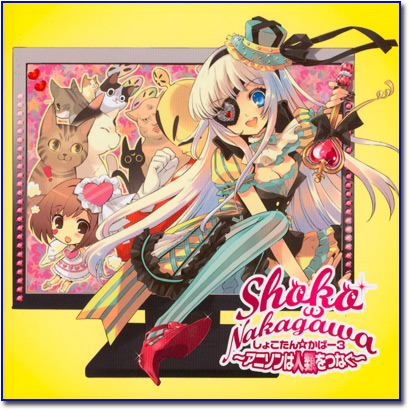
The back cover is a nice contrast to the front cover, featuring a genuine photograph of Nakagawa opposite the track listing for the album.
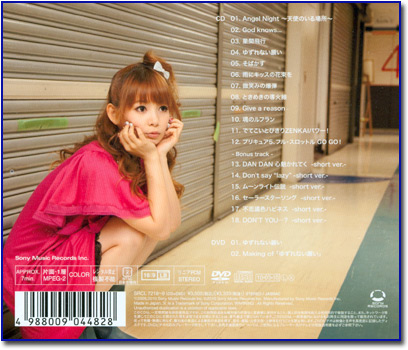
The inside lyrics are, for the most part, very readable. They are generally opposite a photo of Nakagawa in a new outfit each time, and are up against a plain, white background.
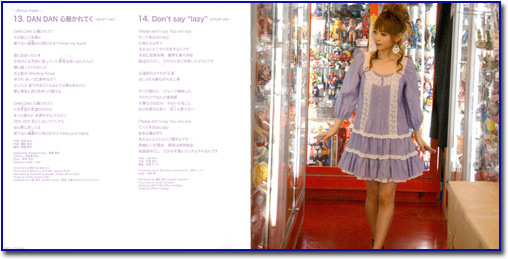
The one exception just happens to be the only full-length DragonBall song on the CD, which is unfortunately splashed against a two-page photo spread of Nakagawa, rendering the lyrics slightly unreadable:
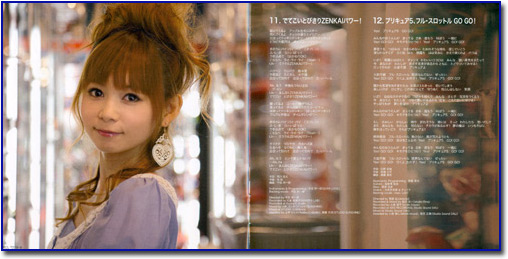
First-press editions of the album came with a small sticker which features the album's cover art:
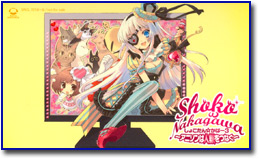
So how about that music...?
Of the two DragonBall songs on this release, I was most curious about this track. I had a rough idea as to how the GT song would come out, but Z's first ending theme is such as weird one... and Nakagawa herself is such a weird one... could it work? Or would it just be a disaster?
The unintelligible lyrics at the very beginning of the song appear to be different unintelligible lyrics compared to the original version, and really does not give any indication as to what you are in for. Somehow the song does give off an air of "cat" to it right from the start, though. It may be the type of "twang" being used combined with Nakagawa's first "Yah!"... but whatever this feline-feeling is, it does not stick around for the entire song.
As the first verse kicks in, Nakagawa's delivery style is somewhat casual and cool, as if she is aware she is being a little too sly in the delivery and purposefully holding back. It really works for this type of song, which definitely has more of a dance vibe to it than the original ever did. Fans of the original version will be happy to hear that all of the background vocal elements are kept in their appropriate places (little yells of "Hey!", for example). It is arrangements like this that do a fantastic job of modernizing an older song while still paying the proper respects.
The instrumentation of the song, as noted, leans much more toward a dance style than the original. It works very well, and is not entirely foreign territory for the song — Hit Song Collection 8 ½ back in 1991 featured a "Super House Version" of the song which tip-toed in this realm. It certainly works, and was a great direction to go in. It does have its own flair at times (the "solo" around the two-minute mark is not note-for-note comparable to the original version), but it always feels appropriate.
Nakagawa's delivery is clear and distinct. The song references the original version at key points and puts its own spin on things at the same time. It does not do a whole lot to set itself apart as a truly spectacular cover song, though. What may work in its favor more than anything else (and primarily for DragonBall fans more than the standard Nakagawa fan) is how few times this song has been covered or even remixed. While the numerous "Romantikku Ageru yo" covers became a joke several years back, this is a song we rarely hear receive any attention. It almost gets a nod-of-approval based on that fact alone.
Based on her prior work, I was fairly confident that Nakagawa would perform adequately on this song, so fondly remembered by many a fan. It is an interesting situation, though — while originally performed by Field of View for the DragonBall franchise, it was actually written by the late Izumi Sakai, the main presence behind Zard (who herself would go on to pen and perform what would be used as the second ending theme to DragonBall GT, "Don't you see!"). Here is a song written by a female to be performed by a male vocalist (and then performed by Sakai herself later that same year), again returning to a female performance. Sakai has a very devoted fanbase that looks up to her with extreme admiration. Would the young and moderately-bonkers Nakagawa have the class to really pull it off? I thought so, but would I end up disappointed?
Unfortunately, the song is only TV-sized in length (clocking in at just under two minutes), and is only available on the "Special" version of the album. I say "unfortunately" because, both to my simultaneous expectations and shock somehow, it is a fantastic little cover of the song!
The instrumentation and production values do feel somewhat "cheap" in this song (covered up in the Z ending theme's cover due to its inherent "weird"-ness), but that may be the only slight against it I can dig up. Nakagawa's vocals are bright and cheerful, and manage to bring across an edge of maturity I assumed would be sorely lacking.
Some backing vocals could have fleshed out the sound of the song. While the original version did not feature any harmonized "ooohs" and "aaahs", its full-band performance gave a warmth and "full"-ness to the song that is missing in Nakagawa's cover.
Nakagawa's cover of the song is chipper and pleasant to listen to. It is a shame that we only have a TV-sized version on the disc!
Having led off with a version of the first DragonBall TV series' ending theme, it was apparent from the start that Nakagawa (or perhaps her managers and producers...) had an interesting vision for this line of cover albums: bring in the heavy-hitting song every so often, but focus on songs that are traditionally given less attention but still hold a lot of weight in their respective fandoms.
This is more apparent than ever before with her third release, now a complete album instead of a five-track EP — it leads off with none other than the opening to City Hunter 2, followed by an insert song from The Melancholy of Haruhi Suzumiya...! The more-current, "otaku"-specific shows and songs are certainly littered around the disc, but are grossly outnumbered by 90s anime favorites such as "Tokimeki no Dôkasen", the ending theme to Fushigi Yûgi.
Much like with the DragonBall GT theme song, Nakagawa travels into slightly unwelcome territory by potentially stepping on the shoes of Megumi Hayashibara, a woman who did everything Nakagawa wants to do before she ever did it, and with far more talent. Shockingly enough, Nakagawa's cover of "Give a reason" (the opening theme to Slayers NEXT) has the same "respectful" feel to it that the Zard / Field of View cover had. Nakagawa event adjusts her delivery style to more appropriately match the tone of the song originally set by Hayashibara. Whether this was her own intent or the careful attention of her producers is up in the air, but someone is paying attention behind-the-scenes.
Nakagawa revisits Rurouni Kenshin again with a cover of its first opening theme, "Sobakasu" (her prior cover album's lead single was "1/2", the series' second opening theme). Much like her cover of "DAN DAN Kokoro Hikarete 'ku", it features an appropriate amount of happiness to match the original performance and allows Nakagawa to feel at home in the song.
Those picking up the "Special" edition of the album will be treated to TV-sized versions of both the Sailormoon and Sailor Stars opening themes, welcome additions right alongside the DragonBall GT opening. Both songs fit well with Nakagawa's performance style.
The lead single off of the album is track four, "Yuzurenai Negai", which is the first opening theme to Magic Knight Rayearth. The included DVD (which comes packaged with both versions of the album) features the music video for this track, as well as a short "Making Of" for the music video.
The promotional music video features Nakagawa making slight dance gestures over a bright and colorful background. Her lip synching does not quite match up with the enthusiasm actually present in the song's recording, which is a shame. There is also a side story featuring a young girl who draws a character that ends up becoming slightly animated with tears on her paper.
The music video runs just under four minutes, while the "Making Of" runs for just over three minutes. The DVD is pressed as Region 2, anamorphic widescreen, and is an interlaced encode.
If you are only a DragonBall fan, there is nothing on the DVD that you will find of interest. As with the rest of the album, fans of 90s anime may get a kick out of seeing a new version of the Rayearth theme performed, but beyond that, it is standard idol fare (in a totally "safe" way, that is... there are no revealing outfits and no cats about to be made into lunch).
DragonBall-exclusive fans should not purchase this album, unless you are of the absurdly-completist variety. There is simply not enough to hold your interest here. You will be paying for a single full-length version of a song, and paying a premium on top of that for just a TV-sized version of another song.
If you are a fan of anime theme songs in general, however... and specifically a fan from the 90s... this cover album may be right up your alley. Nakagawa hits all the right series, and furthermore, hits a pretty impressive variety of songs without exclusively relying on "the big hits" from each of those shows. Having a couple choice hits from DragonBall is nothing to sneeze at.
If you are considering picking up the album at all, there is no reason not to pick up the special edition. If you are a DragonBall fan you will want the special edition for the DragonBall GT opening theme, but you will also gain a couple of its contemporaries such as the Sailormoon opening themes. It is only a couple bucks more on top of what you are already paying, and while that is their whole "Gotcha!" for this kind of release, it is worth it in this case.
For another look at this CD with samples from each relevant song, check out episode #0218 of our podcast.
Shoko-tan Cover 3 is available in both its special and regular editions at these online retailers:
|